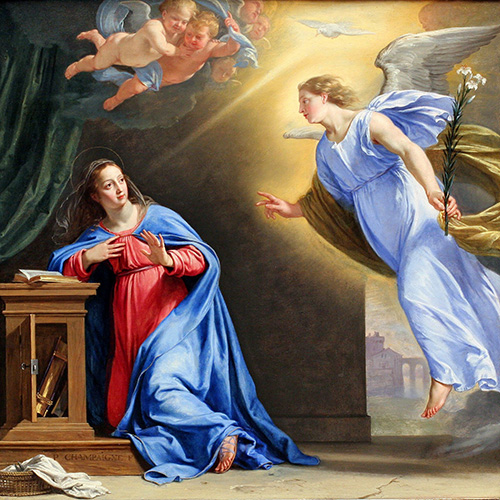March 25 (celebrated April 9 this year)

According to the revised New American Bible, the Annunciation, when the archangel St. Gabriel tells Mary she has been chosen to be the mother of God, the Son, is the exact moment of the Incarnation. The encounter, with Mary’s questioning and acceptance, is described in Luke 1: 26-38:
“In the sixth month, the angel Gabriel was sent from God to a town of Galilee called Nazareth, to a virgin betrothed to a man named Joseph, of the house of David, and the virgin’s name was Mary. And coming to her, he said, ‘Hail, favored one! The Lord is with you.’ But she was greatly troubled at what was said and pondered what sort of greeting this might be.
“Then the angel said to her, ‘Do not be afraid, Mary, for you have found favor with God. Behold, you will conceive in your womb and bear a Son, and you shall name Him Jesus. He will be great and will be called Son of the Most High, and the Lord God will give Him the throne of David His father, and He will rule over the house of Jacob forever, and of His kingdom there will be no end.’
“But Mary said to the angel, ‘How can this be, since I have no relations with a man?’ And the angel said to her in reply, “The Holy Spirit will come upon you, and the power of the Most High will overshadow you. Therefore the Child to be born will be called holy, the Son of God. And behold, Elizabeth, your relative, has also conceived a son in her old age, and this is the sixth month for her who was called barren; for nothing will be impossible for God.’
“Mary said, ‘Behold, I am the handmaid of the Lord. May it be done to me according to your word.’ Then the angel departed from her.”
In one of the readings from the Liturgy of the Hours for the day, Pope St. Leo the Great reflects on the mystery of Jesus’ conception: “He who is true God was therefore born in the complete and perfect nature of a true man, whole in His own nature, whole in ours. BY our nature we mean what the Creator has fashioned in us from the beginning, and took to Himself in order to restore it.”
This liturgical feast, first celebrated in the East, was introduced in Rome between 660 and 680. The oldest liturgical books called it “Adnuntiatio Domini,” the Annunciation of the Lord, but during the Middle Ages it was popularly celebrated as a Marian feast, the Annunciation to the Virgin Mary. The 1969 revision of the Roman liturgical calendar restored the feast as a Solemnity of the Lord and restored its ancient title. Because March 25 falls during Holy Week this year, it has been moved in the calendar to April 9.
Annunciation Catholic School in Cave Creek is under the patronage of the Annunciation.






